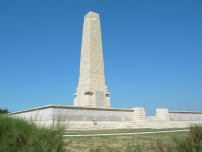| First Name: | Jack | Last Name: | LACEY | |
|---|---|---|---|---|
| Date of Death: | 10/08/1915 | Lived/Born In: | Chiswick | |
| Rank: | Private | Unit: | Wiltshire5 | |
| Memorial Site: | Helles Memorial, Gallipoli | |||
Current Information:Age-20 51, Church Path, Acton Green, Chiswick
Gallipoli On 25 April, British, Australian and New Zealand forces landed on the Gallipoli peninsula. The plan was that these forces would soon defeat a demoralised Turkish army, knock Turkey out of the war, open up the Mediterranean to the Russian navy and threaten Austro-Hungary from the south. None of these things were achieved despite nine months of hard fighting in terrible conditions. It was a heroic failure. By July, 1915, and after much fierce fighting, stalemate had set in at Gallipoli both at Cape Helles where the British and French had landed and at Anzac Cove where the Australian and New Zealand Corps were unable to break out of their beach head. Fresh troops were needed and they were on their way in the shape of four divisions from Britain and things were put on hold until they arrived. The plan for August was for a landing at Suvla Bay to the north of Anzac Cove whilst at the same time, the ANZAC Corps, reinforced by some of the new British troops would effect a breakout from Anzac Cove and establish a line across the peninsula. Whilst this was going on the troops in the south at Helles would stage a number of diversionary attacks. But it all went horribly wrong and much of the reason for this can be explained by inadequate planning and leadership. Nobody seemed to know what they were supposed to be doing and Lieutenant-General Stopford, in charge of the Suvla landings was particularly out of his depth. The landings at Suvla failed to link up with the forces at Anzac and the breakout from there did not happen despite valiant efforts by all concerned. The loss of life on all fronts was again enormous. L.A. Carlyon’s excellent book “Gallipoli” gives a superb yet chilling account of the events. By 17th July, 1915, all three brigades the 13th Division had reached Helles and on 4th August, the 5th Wiltshire battalion of 40 Brigade moved to Anzac Cove in readiness for their participation in the August attack. During the night of 6/7th August they were part of the force that made their way northwards up the coast before turning inland to attack the heights of Sari Bair from the north with the objective of capturing Hill 971. On 8th August Chunuk Bair had been captured by a force of New Zealand and British troops and the following night, the New Zealanders were relieved and replaced by the 9th Lancashire Fusiliers and 5th Wiltshire battalions. This order arrived late at the HQ of 5th Wiltshire and just over half the battalion set out, reaching the slopes of Chunuk Bair at 3am on 10th August. On arrival there was no room for them in the forward trenches so they had to trudge across to the precipitous slopes of Sazli Dere where they tried to sleep for the first time in four days. At 4.45am The Turks attacked in force and the Lancashire Fusiliers were swept from their trenches on or near the summit of Chunuk Bair. The enemy then fell on 5th Wiltshire, most of whom had been asleep. The Turks wreaked havoc as they charged down the slopes, shooting and bayoneting all in front of them. Very few survived this onslaught and those that did went hurtling down the steep slopes, in the gloom of dawn, to the valley, some 200 metres below. For two weeks a group of them were stranded there, getting water from a spring and food from the dead. Turkish patrols came upon them but refused to take them prisoner and eventually most of them tried to make a rush down the valley only to be shot by New Zealand soldiers who mistook them for Turks. Seven of their number remained behind. Two managed to climb up to Rhododendron Spur and the New Zealanders then climbed down and rescued the other five. One of the very many casualties suffered by 5th Wiltshire was Jack Lacey. |
||||
| « Back to Search Results | ||||
| If you think any of the information shown here is incorrect, Click Here to submit your amends and comments | ||||




